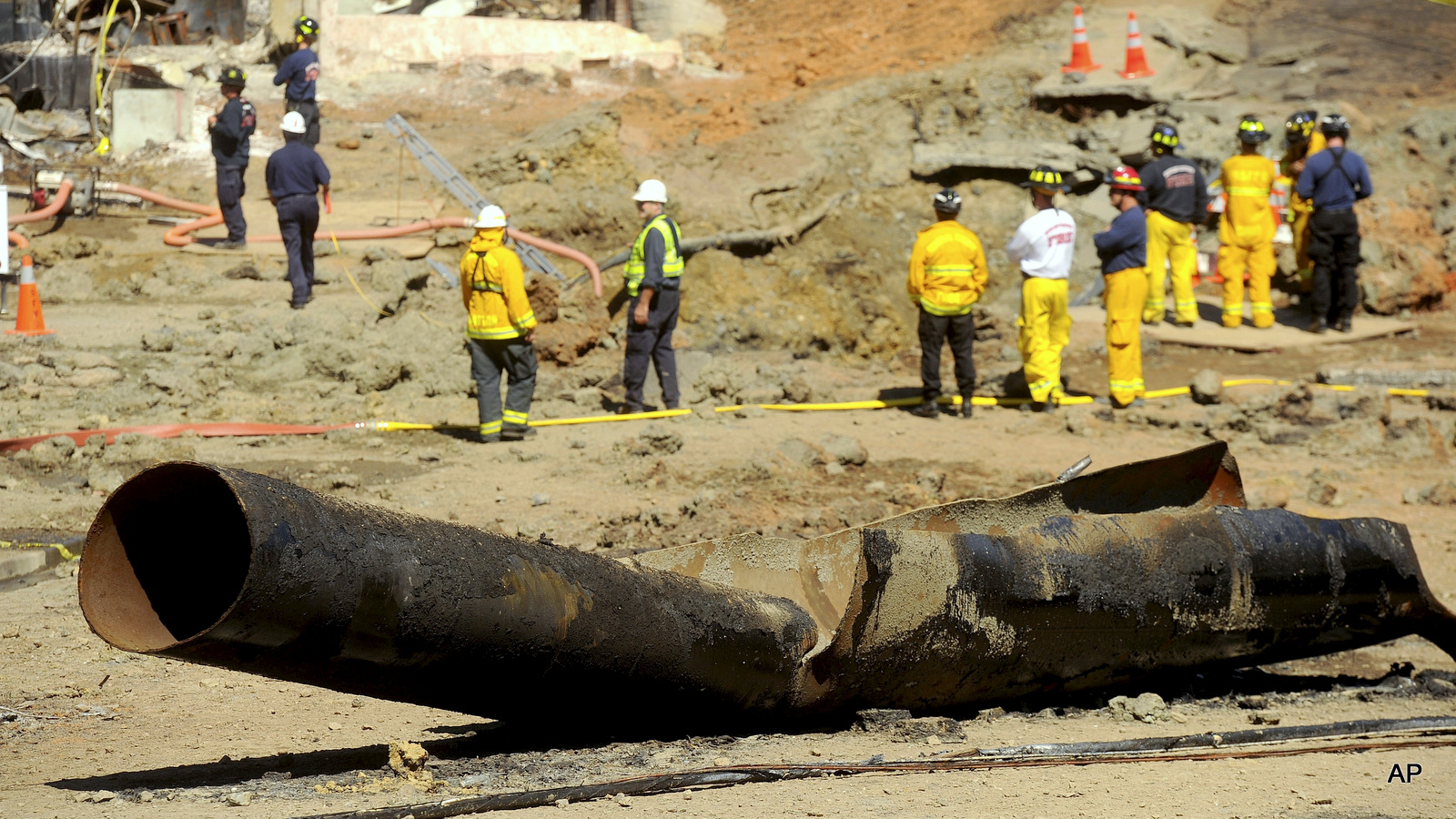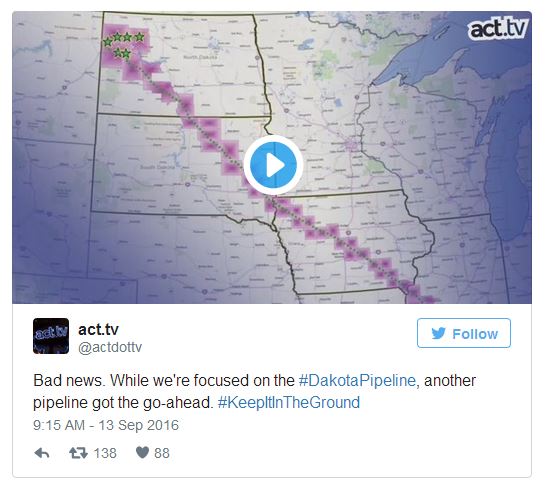What’s Behind The Surge In US Pipeline Construction?
By Kit O’Connell,
MintPress, 20 September 2016. Native American activist Winona
LaDuke explained that the US would rather ‘create this filthy infrastructure’
through the Dakota Access Pipeline and other domestic fossil fuel projects than
do business with Venezuela.
MintPress, 20 September 2016. Native American activist Winona
LaDuke explained that the US would rather ‘create this filthy infrastructure’
through the Dakota Access Pipeline and other domestic fossil fuel projects than
do business with Venezuela.

FILE – In this Sept.
11, 2010, file photo, a natural gas line lies broken on a San Bruno, Calif.,
road after a massive explosion. The blast of a Pacific Gas & Electric Co.
natural gas pipeline sent a giant plume of fire into the air in a neighborhood
in San Bruno, killing eight people and destroying 38 homes.
11, 2010, file photo, a natural gas line lies broken on a San Bruno, Calif.,
road after a massive explosion. The blast of a Pacific Gas & Electric Co.
natural gas pipeline sent a giant plume of fire into the air in a neighborhood
in San Bruno, killing eight people and destroying 38 homes.
AUSTIN, Texas — The Dakota
Access pipeline is just one of several major fossil fuel projects underway as
part of U.S. efforts to dominate the global energy market and crash the
oil-dependent economies of American nemeses like Venezuela and Russia.
Access pipeline is just one of several major fossil fuel projects underway as
part of U.S. efforts to dominate the global energy market and crash the
oil-dependent economies of American nemeses like Venezuela and Russia.
On Monday, a federal charge
officially halted construction
around Lake Oahe, the site of a massive protest
against the Dakota Access pipeline led by the Standing Rock Sioux, who have
been joined by hundreds of other Native American tribes and indigenous groups.
officially halted construction
around Lake Oahe, the site of a massive protest
against the Dakota Access pipeline led by the Standing Rock Sioux, who have
been joined by hundreds of other Native American tribes and indigenous groups.
Elsewhere, however, expansion of
U.S. fossil fuel infrastructure continues.
U.S. fossil fuel infrastructure continues.
Winona LaDuke, a respected Native
American activist and executive director of Honor The Earth, put the Dakota Access pipeline and others like it into
international perspective during a July 12 interview withDemocracy Now!. LaDuke explained:
American activist and executive director of Honor The Earth, put the Dakota Access pipeline and others like it into
international perspective during a July 12 interview withDemocracy Now!. LaDuke explained:
“[I]t also has to do with
crushing Venezuela, because Venezuela has the largest oil reserves in the
world. And rather than do business with Venezuela, they were bound and
determined to take oil from places that did not want to give it up, and create
this filthy infrastructure.”
crushing Venezuela, because Venezuela has the largest oil reserves in the
world. And rather than do business with Venezuela, they were bound and
determined to take oil from places that did not want to give it up, and create
this filthy infrastructure.”
In order to reduce its dependence
on South American and Middle Eastern oil, the United States is turning to
domestic energy sources that are especially toxic to the environment. LaDuke
continued:
on South American and Middle Eastern oil, the United States is turning to
domestic energy sources that are especially toxic to the environment. LaDuke
continued:
“So, this carbon—this oil is very
heavy in carbon and will add hundreds of millions of tons of CO2 to the environment,
if these pipelines are allowed through. So, that is—you know, it affects
everybody.”
heavy in carbon and will add hundreds of millions of tons of CO2 to the environment,
if these pipelines are allowed through. So, that is—you know, it affects
everybody.”
A recent gas pipeline rupture in Alabama brought into sharp relief
the threats the Dakota Access pipeline and many similar projects pose for
crucial waterways and vulnerable ecosystems. In January, the North Dakota
Public Service Commission, with approval from area tribes, granted permits
to Sacagawea Pipeline Co. to build a crude oil
pipeline that crosses Lake Sakakawea, an important reservoir in the state.
the threats the Dakota Access pipeline and many similar projects pose for
crucial waterways and vulnerable ecosystems. In January, the North Dakota
Public Service Commission, with approval from area tribes, granted permits
to Sacagawea Pipeline Co. to build a crude oil
pipeline that crosses Lake Sakakawea, an important reservoir in the state.
The Sacagawea pipeline would
transport 140,000 barrels of oil per day to a railway line owned by Phillips
66. In addition to pipelines, oil trains are also a
major source of concern for environmental safety activistsdue to their potential for devastating and explosive derailments.
transport 140,000 barrels of oil per day to a railway line owned by Phillips
66. In addition to pipelines, oil trains are also a
major source of concern for environmental safety activistsdue to their potential for devastating and explosive derailments.
On Sept. 6, the Lebanon Hills pipeline received final approval
for construction to begin in Dakota County, Minnesota, south of Minneapolis and
St. Paul. Operated by the Northern Natural Gas company, this pipeline will
supply fuel to the Xcel Black Dog Power Plant in Burnsville, Minnesota, a
coal-burning power plant that’s in the process of being converted to natural
gas.

for construction to begin in Dakota County, Minnesota, south of Minneapolis and
St. Paul. Operated by the Northern Natural Gas company, this pipeline will
supply fuel to the Xcel Black Dog Power Plant in Burnsville, Minnesota, a
coal-burning power plant that’s in the process of being converted to natural
gas.

But the pipeline’s path runs
across some of the region’s most delicate wetlands. “As planned, it will cut
through Lebanon Hills Regional Park’s ‘preserve zone’ — an area of high
ecological diversity — and affect more than 400 landowners,” wrote Emma Nelson,
a reporter for the Star Tribune, on Sept. 10.
across some of the region’s most delicate wetlands. “As planned, it will cut
through Lebanon Hills Regional Park’s ‘preserve zone’ — an area of high
ecological diversity — and affect more than 400 landowners,” wrote Emma Nelson,
a reporter for the Star Tribune, on Sept. 10.
The Sabal Trail Pipeline, a joint project of Spectra
Energy Corp, NextEra Energy, Inc., and Duke Energy, is also sparking outcry
from concerned residents and environmental justice activists. Critics say the
project, described as a Southeast “gas highway,” will have the most adverse
effects on low-income, minority neighborhoods, including high degrees of
displacement. In October 2015, four congressmen from Georgiawrote a joint letter to the
Federal Energy Regulatory Commission expressing their concerns. It reads in
part:
Energy Corp, NextEra Energy, Inc., and Duke Energy, is also sparking outcry
from concerned residents and environmental justice activists. Critics say the
project, described as a Southeast “gas highway,” will have the most adverse
effects on low-income, minority neighborhoods, including high degrees of
displacement. In October 2015, four congressmen from Georgiawrote a joint letter to the
Federal Energy Regulatory Commission expressing their concerns. It reads in
part:
“Sabal Trail’s proposed route
will go through Albany and Dougherty County and will run through low-income
African-American neighborhoods. The proposed industrial compressor station
facility would sit right in the middle of an African-American residential
neighborhood comprised of two large subdivisions, a mobile home park, schools,
recreational facilities, and the 5,000-plus member Mount Zion Baptist Church, a
predominantly African-American congregation.”
will go through Albany and Dougherty County and will run through low-income
African-American neighborhoods. The proposed industrial compressor station
facility would sit right in the middle of an African-American residential
neighborhood comprised of two large subdivisions, a mobile home park, schools,
recreational facilities, and the 5,000-plus member Mount Zion Baptist Church, a
predominantly African-American congregation.”
And in Texas, the Trans-Pecos
pipeline, another project of Energy Transfer Partners, the builder behind the Dakota Access pipeline, threatens
the land of dozens of ranchers, the iconic and
mysterious Marfa Lights, and some of West Texas’ last untouched wilderness in the course of carrying
natural gas to Mexico.
pipeline, another project of Energy Transfer Partners, the builder behind the Dakota Access pipeline, threatens
the land of dozens of ranchers, the iconic and
mysterious Marfa Lights, and some of West Texas’ last untouched wilderness in the course of carrying
natural gas to Mexico.
By flooding markets with cheap
oil and gas from sources like fracking, the United States has helped send
global oil prices plummeting. This, in turn, has contributed to Venezuela’s economic crisis and poor economic
indicators in Russia.
oil and gas from sources like fracking, the United States has helped send
global oil prices plummeting. This, in turn, has contributed to Venezuela’s economic crisis and poor economic
indicators in Russia.
Political analyst Caleb Maupin, writing in July for MintPress News, argued that the United
States is waging a kind of “economic war” on its oil-rich enemies.
States is waging a kind of “economic war” on its oil-rich enemies.
“While American media insists the
low oil prices are just the natural cycle of the market at work, it’s rather
convenient for U.S. foreign policy,” he wrote. “Russia, Venezuela, Ecuador, and
the Islamic Republic of Iran all have economies centered around state-owned oil
companies and oil exports, and each of these countries has suffered the sting
of low oil prices.”
low oil prices are just the natural cycle of the market at work, it’s rather
convenient for U.S. foreign policy,” he wrote. “Russia, Venezuela, Ecuador, and
the Islamic Republic of Iran all have economies centered around state-owned oil
companies and oil exports, and each of these countries has suffered the sting
of low oil prices.”
Watch “Native American Activist Winona
LaDuke: It’s Time to Move On from Fossil Fuels” from Democracy Now!
LaDuke: It’s Time to Move On from Fossil Fuels” from Democracy Now!


